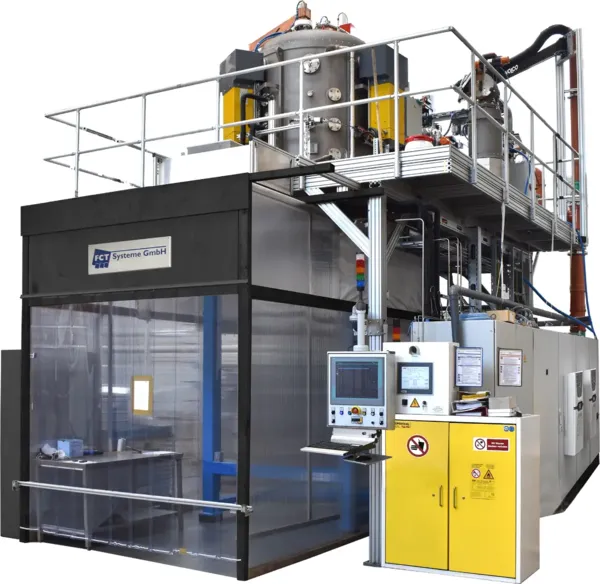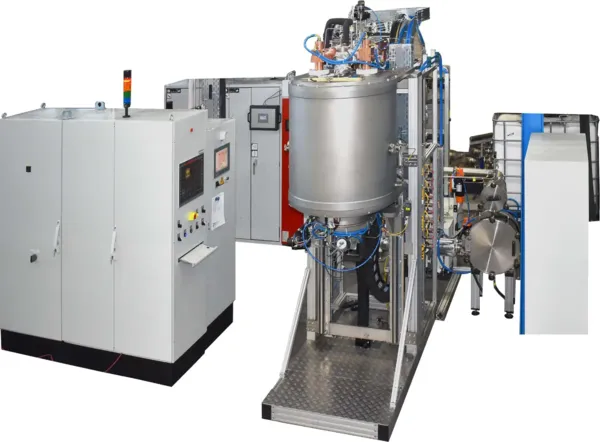We offer and supply standard and customised Thermally Induced Chemical Vapour Deposition & Infiltration Plants (CVD & CVI) in pilot and production scale.
Chemical Vapour Deposition (CVD) & Chemical Vapor Infiltration (CVI)
Chemical Vapour Deposition (CVD)
Thermally induced Chemical Vapour Deposition (CVD) is a process used to create thin films of various materials on a substrate surface through the chemical reaction of gases. In this process, a precursor gas or a mixture of gases is introduced into a reaction chamber where it reacts and forms a solid film on the surface of the substrate. The chemical reaction occurs at high temperatures and low pressures to promote the formation of a thin and uniform film.
CVD is commonly used to produce a wide range of materials, including semiconductors, metals, ceramics, and diamond coatings. The properties of the resulting film depend on the specific precursor gas used and the reaction conditions. The advantages of CVD include the ability to produce high-quality films with precise control over thickness and composition. CVD is widely used in the semiconductor industry, as well as in the production of optical and electronic devices, and in coating applications.
The CVD silicon carbide process (CVD SiC) combines decomposed methyltrichlorolsilane (MTS) with hydrogen at elevated temperature and reduced pressure at a substrate surface for a controlled deposit of pure theoretically dense silicon carbide.
However, one disadvantage of CVD is that it can be very costly to control and monitor the conditions for the reaction and the pressure in the chamber within narrow limits to ensure uniform and controlled film formation, as well as the potential for hazardous waste generation. The latter must be neutralised with suitable waste gas purification plants. Nonetheless, CVD remains an important tool for a wide range of industrial applications, and ongoing research is focused on improving the efficiency and sustainability of this process.
CVD Educts & Products:
- SiC: CH3SiCl3 → SiC + 3HCl
- Si3N4: 3SiCl4 + 4NH3 → Si3N4 + 12HCl
- BN: BCl3 + NH3 → BN + 3HCl
- AlN: AlCl3 + NH3 → AlN + 3HCl
Chemical Vapor Infiltration (CVI)
hemical Vapor Infiltration (CVI) is a process used to produce ceramic matrix composites (CMCs) by infusing carbon fibers or other reinforcing materials with ceramic precursors. The process involves the deposition of a gaseous precursor material onto a porous preform, typically made of carbon fiber, which then reacts to form a ceramic matrix.
The preform (substrate) is placed in a reactor chamber and heated to a high temperature under vacuum or an inert gas atmosphere. A gaseous precursor material, such as a metal organic compound, is then introduced into the chamber and reacts with the carbon fibers in the preform to form a ceramic matrix.
The reaction between the precursor and the carbon fiber is typically driven by heat, with the reaction rate increasing with temperature. The precursor molecules diffuse through the porous preform and deposit onto the carbon fibers, forming a thin layer of ceramic material. This process is repeated multiple times to build up a thicker ceramic matrix and thus reduces the substrates porosity; increasing density. The densification stops once the pores are fully closed.
The advantages of CVI include the ability to produce CMCs with complex shapes and high strength-to-weight ratios. The resulting CMCs are lightweight, strong, and can withstand high temperatures and harsh environments. CVI is used in a variety of applications, including aerospace, defense, semiconductor and energy industries.


